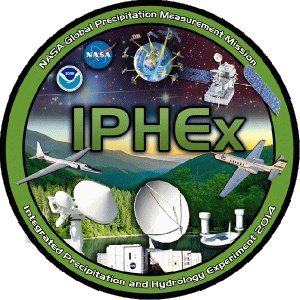
The Integrated Precipitation and Hydrology Experiment (IPHEx), centered in the Southern Appalachians and spanning into the Piedmont and Coastal Plain regions of North Carolina, seeks to characterize warm season orographic precipitation regimes, and the relationship between precipitation regimes and hydrologic processes in regions of complex terrain.
IPHEX-GVFC consists of two activities:
- an extended observing period (EOP) from October 2013 through October 2014 including a science-grade raingauge network of 60 stations, half of which will be equipped with multiple raingauge platforms, in addition to the fixed regional observing system; a disdrometer network consisting of twenty separate clusters; and two mobile profiling facilities including MRRs;
- an intense observing period (IOP) from May–July of 2014, post launch of the GPM Core Satellite, focusing on 4D mapping of precipitation structure during which NASA’s NPOL S-band scanning dual-polarization radar, the dual-frequency Ka-Ku, dual polarimetric, Doppler radar (D3R), four additional MRRs, and two X-band radars (NOAA NOXP, and X-Pol) will be deployed in addition to the long-term fixed instrumentation. During the IOP, the NASA ER-2 and the UND Citation aircraft will be used to conduct high altitude and “in the column” measurements.
The ER-2 will be equipped with multi-frequency-radiometers (AMPR and CoSMIR), the dual-frequency Ka-Ku band, HIWRAP Ka-Ku band, CRS W-band, and EXRAD X-band radars. The ER-2 instrument complement collectively functions as an expanded GPM Core “satellite proxy”. The UND Citation instruments will be dedicated to microphysical characterization.
The ground-based instrumentation sites were selected to collect extensive samples of orographic effects on microphysical properties of precipitation, specifically DSDs, for the dominant warm season precipitation regimes in the region:
- westerly systems including Mesoscale Convective Systems (MCSs) and fronts;
- southerly and southeasterly convective systems and tropical storms;
- convection initiation and suppression and feeder-seeder interactions among fog and multilayered clouds in the inner mountain region.
